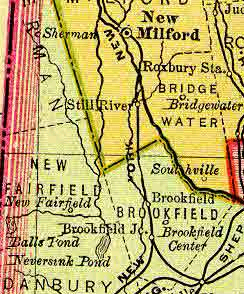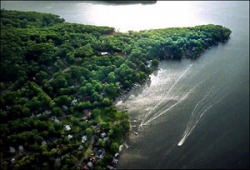A BRIEF HISTORY OF CANDLEWOOD LAKE IN WESTERN CONNECTICUT

Aerial View of the Lake
Candlewood Lake is located in Western Connecticut. It is formed behind a power dam south of the Rocky River's junction with the Housatonic River. Along its 86-mile shoreline are five-star tourist resorts and recreational facilities such as golf courses, beaches, marinas, and numerous small communities which give Candlewood Lake its unique magnetism. The lake is used year round by residents and tourists alike for fishing, boating, golfing, ice sports, and just taking in the atmosphere.
THE BEGINNING OF AN ERA 1895 Roadmap before the Lake
It all began in the early 1900's when hydroelectricity started to become a viable power source for towns and cities in the United States. In 1917 a enterprising lawyer named J. Henry Roraback began buying potential dam sites along the Housatonic and Connecticut Rivers. He also purchased the stock of the Housatonic Power Company and eventually named his combined enterprise the Connecticut Light and Power Co. As president of the company, he had the foresight to see that the economic growth of the area would be increasingly dependent on electric power. By 1919 his utility company completed construction of the Stevenson Dam just above Derby on the Housatonic River and 25 miles below the Rocky River. Then attention was focused on the final formulation of the plan to create a pumped water storage reservoir in the Rocky River basin and build a generating station in New Milford.
CANDLEWOOD LAKE TODAY A toast to the Lake!
Today, Candlewood Lake is the largest lake in Connecticut, and one of the largest man-made lakes in the United States. Although its main purpose for being created was to bring power to the cities around it, the lake actually contributes much more then electricity to its communitites and that is the atmoshere, inspiration, and beauty it gives off daily to all who come in contact with it.
What are people saying about Candlewood Coffee?
|
FIRST STAGES OF CANDLEWOOD LAKE A summer day on the Lake
In July of 1926, Connecticut Light and Power approved a plan that would be unique: The first large-scale operation of pumped storage facilities in the United States. By creating the lake and pumping it full of water from the Housatonic River then letting the water pour down an immense pipe called a penstock and into a turbine, the utility could produce electricity.
Within weeks, an army of 50 surveyors swarmed into the valley, and lawyers were hired to process the deeds transferring land held by some families since before the American Revolution into the hands of CL&P. The utility company had the power of eminent domain so the farmers sold their land between 30 and 70 dollars per acre. Starting in late July, 1926, nearly 1400 men labored to create Connecticut's largest body of water. About 500 men from Maine and Canada, hand-felled 4,500 acres of woodland and burned the lumber in massive bonfires - reminiscent of Indian campfires that once burned in the valley centuries earlier. Several dams were built. The largest, at the north end of the valley, measured 952 feet wide and 100 feet high upon completion. Almost two years later in Febuary of 1928, the first pumping operation began pouring water into the valley from the Housatonic. The valley filled quickly, and only 7 months later, in September of 1928, the water reached an elevation of 429 feet above sea level and Candlewood was considered complete. ARE YOU A COFFEE DRINKER? CHECK OUT OUR COFFEE!
Check out our coffee selection today!
Find a store near you that sells Candlewood Coffee! |